In the front line
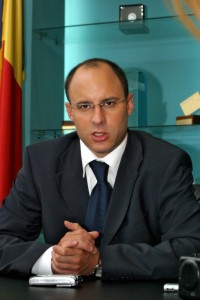 Dynamic. Massive growth. Vast potential. Huge investment. Not words that are often associated with a Romanian industry - unless it's IT & Communications, as Minister Zsolt Nagy tells ‘The Diplomat’ Dynamic. Massive growth. Vast potential. Huge investment. Not words that are often associated with a Romanian industry - unless it's IT & Communications, as Minister Zsolt Nagy tells ‘The Diplomat’
Romania is the most dynamic IT and the telecommunications market in this part of Europe, with the largest growth in the field, assures Zsolt Nagy, Romania's Minister of IT & Communications (IT&C).
Over the last few years the Ministry has dodged the heavy criticism and corruption that has plagued some Government departments.
While the authorities presided over an industry that has seen rapid growth and strong competition, Government interference has been minimal, leaving the market to get on with its own business.
Soon some of the last great state companies in post and telecommunications will be privatised, while the Ministry will also provide two more licenses for 3G operators.
So this, therefore, is what a position of confidence looks like. Not something Romania sees every day.
“The entire IT&C market has an annual growth rate of 20 per cent and we have a mobile phone industry in the process of growing continuously, with the biggest growth rate in central and eastern Europe,” the Minister tells The Diplomat. “There is still a great development potential as the penetration reaches 50 per cent of the population, with about 11 million users of mobile phones.”
While in landline phones, dominated by former state firm Romtelecom, this is only 22 per cent. “Now landline telephony is taking the form of alternative operators' development as well as the modernisation and upgrade of infrastructure to strengthen the position of Romtelecom,” he adds.
The Minister feels the IT market in Romania is also in a full development mood, but the software market is not seeing healthy growth.
“There is too large a proportion of hardware, which could account for up to 70 per cent of the whole market. In the EU the proportions of the market are divided one third each into hardware, software and maintenance and consultancy,” he says. Another local quality is the good presence of specialists, and what Nagy calls “very good” university centres.
Together, the IT&C market is valued at four billion Euro.
“With all these statistics, we still rank low among EU countries or countries that will accede to the EU,” says Nagy. “But we have a constant growth rate of 20 per cent per year, which makes us optimistic that by 1 January 2007 we will be competitive, even the leader in some segments. We have the highest development potential in south-eastern Europe and I believe we can catch up with countries like Greece.”
MAKING EU STANDARDS BY 2009
Competitiveness may be an area where Romania in general is failing to reach western norms, but not here, adds Nagy: “There is real competition on this market, and the state is not an operator but a regulator and insurer of a free, competitive market. If we manage to maintain this growth rate I think that in four or five years we can reach the average EU level.”
However the gap between rural and the urban populations in access to electronic communication is a great concern.
“There are big cities where all the mobile operators are active, plus alternative landline operators, whereas in the countryside there are no options,” says Nagy. “One of the biggest challenges is to bring the rural environment up to these standards, a reason for which we use the existing national infrastructure to develop the local loop access.”
This means, for example, a village that does not have communication access could employ the existing electrical poles and infrastructure to carry land lines.
Other issues include the impending privatisations of Romtelecom (of which 54 per cent is owned by Greek telecom firm OTE), the National Radiocommunications Company (SNR), which transmits radio-waves and Posta Romana (national postal service).
“At the beginning of 2006 we will begin listing some of the 46 per cent of stakes we have in Romtelecom on the Bucharest Stock Exchange,” he says.
By the end of 2005 the third GSM operator, Cosmorom, will relaunch as CosmOTE, following a 120 million Euro investment from Greek firm OTE through its mobile brand and the Minister also wants to develop new technologies such as WiMax, Wi-Fi and PHS.
The Ministry has two 3G licenses left to sell, which will be auctioned by the end of the year, following the purchase of the first two by MobiFon (Connex) and Orange.
Many leaders in the market have stated there is still space for a fourth GSM operator in Romania.
“There could be space for more operators, but at this point there's no available frequency,” Nagy says. “If a virtual operator comes in, it won't have its own network, but will have to use the networks of existing operators. It is related to regulations, and we are considering ideas like this.”
Plans for 2006 include introducing a new regulation that allows customers to keep the same number when they change telephone operators.
“This measure is meant to strengthen competition,” says the Minister. “It is obvious that mobile telephony has a greater potential than landline, but the latter won't be replaced in its entirety.”
|
|
Saved by the bell
Romania seems to be Europe's land of all possibilities in telecommunications. Michael Bird and Ana Maria Smadeanu take a closer look at Romania's fast developing telecom market.
Romania waited for 13 years, following the revolution, before it completely opened up the telecom market and, two years on, changes are starting to register.
In landline telephony there are almost 30 phone operators, one of which, former state firm Romtelecom, has a significant market power and still calls the shots. Here, penetration is only 22 per cent, far behind the European average of 56 per cent.
Mobile telephony, on the other hand, has had a stellar rise. Unlike many European countries, Romania started by issuing two GSM licenses, neither of which were granted to the national telecom operator. The result was that the market developed dynamically and has a penetration rate of 50 per cent.
In the past 15 years all landline communication and postal services in Romania have been open to the market with one major exception - voice communication.
“Here, Romtelecom had some special rights before its privatisation, [which begun in 1998] and for a further five years,” Dan Cristian Georgescu, president of the National Regulatory Authority for Communications (ANRC) tells The Diplomat. “Posta Romana still has some 'reserved rights' on some specific services, like sending light-weight correspondence such as envelopes.”
Although there has been an effective monopoly on landline voice telephony, the remainder of electronic communication was liberalised from the very beginning.
“This includes cable TV, which begun on its own, without any foreign investments, and which has developed so that it now has a bigger penetration than fixed telephony,” says Georgescu. “Also data transmission, which has also been liberalised and there are companies now competing on a free market; and other services in radio communications, satellite transmission and last, but not least, the mobile phone market.”
Opening the market has worked for telecommunications, it seems. Adds Varujan Pambuccian, head of the IT & C Commission within the Chamber of Deputies: “The most important thing for Romania is that we [as the authorities] are keeping true technological neutrality. This means that technology has to be judged by the market, not by the politicians. We are allowing the market to decide.”
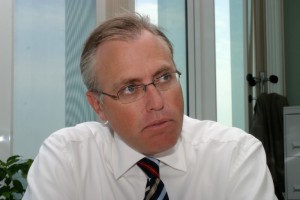 MOBILE HOME MOBILE HOME
Romania saw its first two GSM operators, Connex and Orange, launching commercially in 1997.
Since then, two more mobile phone operators joined the local telecom market, Zapp and Cosmorom, the former of which runs on the CDMA 2000 niche.
Romania currently has over 11 million mobile telephone subscribers, a rate that is rapidly expanding and eclipsing landline telephone users by two to one.
“Because Connex and Orange departed from ground zero in an environment which was competitive from the very beginning,” says Georgescu, “the number of subscriptions has increased at a rhythm which was not in any of their business plans.”
The second factor which helped increase this competition, he says, was the initial low penetration rate of the fixed telephony.
“Romtelecom used to be, and still is, in the unpleasant situation in which it cannot meet all consumer demands,” adds Georgescu.
“Because of this, the mobile telephony has overcome the fixed one.”
GENERATION GAME
The next big wave of develop is the progress of third generation telephony.
With the Ministry of IT & Communications last year auctioning four such licenses, two mobile telecom giants have grabbed the opportunity to prove themselves in the challenging field.
Whereas Connex (now owned by world leader in mobile phone operators Vodafone) has already launched 3G services, its main competitor, Orange, is currently capitalising on its similar EDGE technology, which experts argue has about a third of the capability of 3G.
But market experts say there is still room to grow in the 3G segment.
Ken Campbell, Connex's chief marketing officer says his new British bosses will give the company a stronger position.
“When you have this global scale, the company has influence over handset suppliers, products and services,” he adds. “Connex's 3G was a made-in-Romania thing, but we did it with some support from Vodafone.”
Campbell says that globally one will see the expansion of 3G networks take place and Romania will not escape from this trend.
“We are very pleased with the take-up so far, the enthusiasm for 3G in the high-end consumer and business segment has been phenomenal,” adds Campbell. “We have seen a real buzz around 3G. The terminals have been well-received and we are increasing their portfolio.”
Campbell says Connex already had the infrastructure in place for the 3G launch, which a new operator on the market may find it hard to set up.
“We had the backbone to support 3G launch,” he says. “We had all that has to be ready to handle the capacity needed for 3G. For us the incremental investment was relatively marginal. You would be hard pressed to find other markets where people had rolled out 3G as fast as we had.”
With a success in Italy, but a botched launch in the UK, 3G has, initially, had a mixed response from global consumers.
But the chief marketing officer believes the 3G investment made a lot of sense: “We were very sure and confident we would get returns. We are not trying to pursue half-measures, like EDGE, to defer an investment. This shows our confidence in the Romanian economy.”
In such a competitive environment, Orange Romania boasts a 48 per cent market share, says the company.
After buying a license for 3G from the Government, later this year will be the date for a launch, says Yves Gauthier, outgoing deputy CEO of Orange Romania, although he does not give a firm time.
Part of the France Telecom Group and the most important French investment on the local market, Orange achieved a 624 million Euro turnover last year. Orange has just announced it reached six million subscribers.
Orange has around 20 retail locations in the country and its services are also available through a series of authorised dealers. The company has invested one billion USD in Romania and this year is going to invest more than 200 million USD.
As for backing up the 3G technology, Chinese telecom firm ZTE sees potential on the Romanian market. After Connex and Orange, there will be two further licenses auctioned maybe this year. “Because we are a solution provider we can't take part in the auction, but we are talking with some operators for a potential cooperation,” says president of ZTE Romania Clark Chuanzh, adding he does not exclude the possibility of cooperating with Orange Romania, which ZTE is a global supplier for.
ALTERNATIVE APPROACH
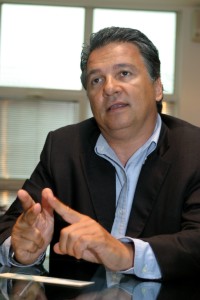 Meanwhile niche mobile brand Zapp launched in Romania in December 2001 using CDMA2000 technology. It is owned by British-based Inquam Ltd, whose shareholders include Qualcomm and Omnia Holdings, an investment fund chaired by Saad Hariri, the businessman-cum-politician who led his party to victory in the recent Lebanese elections. Meanwhile niche mobile brand Zapp launched in Romania in December 2001 using CDMA2000 technology. It is owned by British-based Inquam Ltd, whose shareholders include Qualcomm and Omnia Holdings, an investment fund chaired by Saad Hariri, the businessman-cum-politician who led his party to victory in the recent Lebanese elections.
The company reported a turnover of 76 million Euro at the end of last year, says Cuneyt Turktan, president of the board of directors of Telemobil, the company than runs Zapp mobile. He predicts a turnover of 107 million Euro and an increase in subscribers by a third to 400,000 by the end of 2005. At present, the mobile operator has coverage for 70 to 80 per cent of the population and aims to increase this to 90 per cent by the end of 2005. To fund this, the operator has just announced 50.4 million Euro in further investments.
If Zapp developed quite well over the years and is Europe's most successful CDMA supplier, according to Georgescu, Cosmorom has seen its ups and downs.
The company was majority owned by state telecom firm Romtelecom until this spring, when Greek-based CosmOTE stepped in. The transaction was finalised in mid-July, with the Greek operator pouring in 120 million Euro for a share capital increase and investments in infrastructure development.
Zsolt Nagy, Minister of IT & Communications says of the deal: “Cosmorom's stagnation period is ending after almost five years, and through this deal the competition on the local telecom market is being strengthened.”
Through the deal CosmOTE has taken over 70 per cent of Cosmorom's shares, and pledges to re-launch the mobile operator. The company owns a GSM license and will operate on GSM 1800 and EGSM 900 frequencies based on license modifications approved by the General Inspectorate in Communications and Information Technology.
SPACE FOR A NEW OPERATOR
“Zapp is the best customer of Connex and Orange,” says Turktan. Every month, the company pays between 600,000 and 700,000 Euro to its two big rivals. This is because all the operators pay for the volume of calls their customers receive from rivals.
While Connex and Orange, with the same number of customers, pay each other relatively the same amount of cash for these 'interconnection costs', Zapp, as a niche operator, finds itself with a higher penalty.
This situation, Turktan argues, will penalise another entrant on the market, who will have to factor in these costs. “For newcomers [to the mobile market] this is not very welcoming,” says Turktan.
One leading telecommunication businessman said Connex may have launched the 3G service too fast, before the market was ready for the technology or the coverage could be assured.
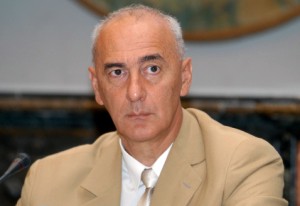 “If a newcomer arrives, it will depend on their technology. It is very expensive to launch UMTS [the technology necessary for 3G],” adds Turktan. The operator will also need more base stations (mobile masts with antennae necessary for receiving and transmitting voice and data) than CDMA. “If a newcomer arrives, it will depend on their technology. It is very expensive to launch UMTS [the technology necessary for 3G],” adds Turktan. The operator will also need more base stations (mobile masts with antennae necessary for receiving and transmitting voice and data) than CDMA.
Zapp claims it is more efficient in its base station use than a 3G operator. “For one base station, we have almost 20 times the coverage that one 3G station has,” he adds.
Adrian Baicusi, general manager of Siemens in Romania, also believes there will be a tough fight ahead.
“It would be hard for a fourth GSM player to come in and have a similar development to Connex and Orange. The first two print the money, the ones that come after that need to earn it.”
Baicusi thinks that if another operator comes in: “it will be able to attain a number of between 500,000 and one million subscribers, but only if it tackles certain niches. Or if it has enough financial reserves so that it can force a drop in prices.”
In this second case, Baicusi says it will be extremely difficult for somebody to come and challenge Orange and Vodafone.
“Vodafone has the advantage that it already introduced 3G,” he says. “Orange should do it sooner or later, as 3G is the future. Orange has the disadvantage that it spent quite a lot on EDGE and is waiting for the return. If a new operator comes in, it cold try to force its entry on the 3G niche.”
He continues: “At this moment we know that Zapp tackles the niche market of transmitting data. Unfortunately it entered the market relatively too early and hasn't managed to cover it entirely. If another operator would come in with a brand new technology, it can very easily overcome Zapp. The problem is that this fourth operator should either use the existing infrastructure or have enough resources to build a new one.”
Turktan agrees that such a new investment must be mighty.
“It will have to have deep pockets,” he says. “It is not guaranteed to make a profit. There will be no short term expectations, only mid to long term.”
But Pambuccian is more optimistic.
“The question is if there's a need for more 3G licenses to be operational,” he says. “I think two licenses was the demand from the operators' part. If the other two licenses were not 'attacked' by the operators, it seems that, for the moment, it is not something that makes sense from an economical point of view.”
However he feels Romania needs more a fourth license on GSM. “I strongly believe that for pure voice, GSM has a brilliant future, in combination with other technologies, probably the future mobile handset will be at least dual-mode: GSM plus something else,” says Pambuccian.
|
HOW MATURE
IS THE MARKET? |
With so many services on offer, one ordinary consumer may wonder if Romania is indeed a mature market - at least compared to neighbouring countries.
“A mature market is a market that has at least 90 per cent GSM penetration. Romania now has a 50 per cent GSM penetration,” says Pambuccian. “I don't think the increase of penetration can be planned by the authorities. We are talking about a market in which the rules are very clear. The companies are doing a great job here, why should we harm them?”
AUGUST 2005 PENETRATION
Mobile: 50 per cent of the market
Landline: 22 per cent of the market
Internet: Five per cent of the market
PREDICTIONS FOR 2007
Mobile: 75 per cent
Landline: 25 per cent
Internet: 15 per cent
DEFINITION OF
A MATURE MARKET
Mobile: 95 per cent
Landline: 30 per cent
Internet: 25 per cent
|
|
Call to action
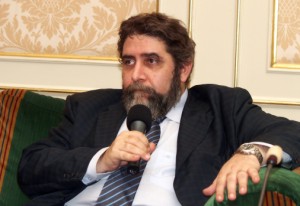 Bold steps by both authorities and companies still need to be taken to bring the market in line with EU standards by 2009, as the Ministry forecasts Bold steps by both authorities and companies still need to be taken to bring the market in line with EU standards by 2009, as the Ministry forecasts
Government and businesses are bridging the telecom gap between the rich and poor areas of Romania in order to try to develop an information society to rival western and central Europe.
Making sure the local loop takes everyone into its circle is therefore a priority - this loop is the wire connection from a telephone firm's central office to its customers' telephones in home and business which can supply telephone and Internet.
The Government has included extending the local loop in its 2007 to 2013 National Development Plan which will be funded, most likely, from the state budget.
“Such an approach will reduce the gap compared to the developed countries as well as benefiting the economy, culture and social life,” hopes Zsolt Nagy, Minister of IT&C.
The National Regulatory Authority for Communications (ANRC) is running several projects to help narrow the telecom gap between rural and urban areas.
“These include regulating the interconnection tariffs between Romtelecom and all other operators,” says Dan Cristian Georgescu, president of ANRC. The result of this will be a cut in the costs of tariffs between competing phone companies. At present there is an extra cost of 2.55 Euro cents per minute between two phone companies at a national level. This cost is shared between the phone operators, but the consumer is the one who finally pays.
Due to volume, the largest operators tend to benefit the most from such costs. But by 1 October ANRC has suggested this should drop to 1.71 Euro cents and by 1 January 2007 to 1.35 Euro cents.
GETTING EVERYONE CONNECTED
“Another major project is the implementation of the Universal Service, a European directive that states everyone has to have access to a phone,” says Georgescu. “This service is included in the European Commission's directives and the Romanian legislation. ANRC is applying the Government's policy in this field.”
One way of getting everyone connected is through telecentres. These are community-based destinations with computers and telephones established in remote areas of the country. They are set up in a joint partnership between local authorities, the state and a telephone operator. Around 25 are now in existence. ANRC says they have proven to be both popular and useful.
The authority gives an example: in a locality during stormy conditions with no road access, a heavily pregnant woman found herself going into labour. There were no public phones, or access for an ambulance. After going to the local telecentre, a friend called a doctor who recounted, over the phone, the steps necessary to deliver a baby. So there, among the wires and monitors of the telecentre, she gave birth.
“We will build about 100 telecentres this year,” adds Georgescu, who needs the backing of the operators. “It is a positive outcome because, for example, Romtelecom was not ready to invest in such centres in 2004 but this year it changed its strategy and wants to invest in them.”
LANDLINE COMPETITION
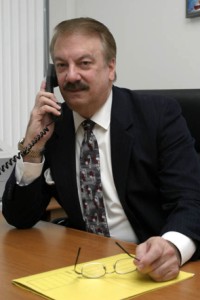 At present there is a low presence of alternative phone operators compared to the dominant phone company, Romtelecom. But the opening up of access to the former state firm's own infrastructure and the potential establishment of new landline networks to compete with the market leader show that not everyone has given up on landline telephony yet. At present there is a low presence of alternative phone operators compared to the dominant phone company, Romtelecom. But the opening up of access to the former state firm's own infrastructure and the potential establishment of new landline networks to compete with the market leader show that not everyone has given up on landline telephony yet.
Cristian Copilau, marketing and communications manager for GTS Telecom believes an interesting challenge for the authorities is the management of the Local Loop Unbundling process. This means that other phone operators can use the local loop network other than incumbent Romtelecom. This aims to increase competition.
“From a business perspective Romtelecom will fight two battles; one to raise barriers and limitations to all alternative operators trying to access the Unbundled Local Loop, and secondly to re-launch a price war with the rest of the operators not needing their infrastructure,” he adds.
Romtelecom is the only real major player on the landline network, with 4.2 million subscribers. Dan Pazara, corporate affairs director at the company says that one particular request from clients is related to broadband Internet access, mostly in the business sector, adding that Romtelecom intends to become market leader in the Internet and data field by 2008 with a market share of over 70 per cent.
The company has spent the past two and a half years modernising its business in digitalising the network and implementing modern support systems. Pazara says Romtelecom will be heavily investing over the next five years in what it calls the Next Generation Network or NGN. A completely new network technology according to Pazara, NGN will allow Romtelecom to offer broadband services, such as very high speed Internet access, content services such as video on demand, interactive games and a host of data services for business customers. “Romtelecom is finalising the upgrade of the telecom network infrastructure and will install last generation equipment in Bucharest. These works meant investments of almost 25 million Euro,” says the corporate affairs director.
Chinese-based ZTE entered the Romanian market in 2002 and tried a partnership with Posta Romana in 2003 for the Postelecom project, which aims to set up an alternative landline infrastructure to Romtelecom wires, masts, phone operators and all.
ZTE is the equipment supplier for Postelecom and a possible partner for the project, which has yet to begin. For the moment the Chinese company has no shares in the project, but telephone operator China Unicom has been interested in investing on the Romanian market.
“It is a pity that we haven't started yet the project, both ZTE and Posta Romana have invested a lot of money and energy in this project,” says Clark Chuanzh president of ZTE Romania. For the moment ZTE has no shares in the project, but China Unicom has 29 per cent.
According to Chuanzh, there is room for another telecommunication company to develop a business in Romania, because it still lags behind central Europe in terms of its market penetration.
“Both Hungary and Czech Republic have 35 per cent penetration for the landline telephony and almost 100 per cent for mobile,” he says. “Romania has only 22 per cent on landline and 50 per cent in mobile, which means a lot of potential.”
CONSUMER WANTS
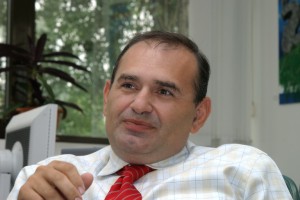 The basic package is still the most popular among consumers, argues Imfred de Jong, managing director for Hungary and Romania with Nokia. The basic package is still the most popular among consumers, argues Imfred de Jong, managing director for Hungary and Romania with Nokia.
“The main tendency in demand is still for basic communication features, voice and SMS, but we see a growing interest for devices that help you organise, access vital information, exchange various documents and finally drive efficiency in business and quality in leisure,” he says.
Nokia wants to maintain its market leading position by offering its users the latest technologies, an attractive design, innovative reliable features, and a user friendly interface, says de Jong.
“As the market is developing, Romanian users become more and more acquainted with a handset's features and how the mobile device can solve their communication needs, thus the need for reliable handsets, with advanced features and a modern design,” he adds.
While Aurelian Sima, country manager of Motorola Romania, says the market is now mature, with more sophisticated handsets with data transfer and entertainment available to consumers.
“In Romania the mobile phone is used more as a voice communication device and it represents an indispensable instrument for business people,” says Sima.
This is not a peculiar market, argues Siemens Romania general manager Adrian Baicusi.
“The Romanian telecommunication market is not very much different in evolution terms from neighbouring countries,” he tells The Diplomat. “The main differences have appeared on segments of the telecom market. In Romania, the mobile part has witnessed a much more rapid and dynamic development than in Hungary and Bulgaria, for example. Bulgaria had a very dynamic evolution in landline networks, whereas Hungary had a more balanced development.”
However, he believes the fast mobile phone development in Romania was due to specific conditions.
“Romtelecom had a monopoly and its late privatisation caused a lost start in the development of landline networks in Romania, so that the demand for communication shifted towards mobile telephony,” says Baicusi. “Orange and Vodafone have this way managed to impose themselves on this market.”
CASHING IN ON INFRASTRUCTURE
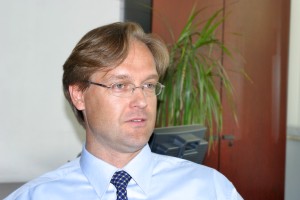 Some of the largest deals have happened in the telecom field between the Government and private companies, especially when building up the infrastructure to reach European Union standards. Ericsson, together with the Special Telecommunications Services (STS), has connected up the European-standard 112 emergency number for Romanian citizens in trouble. Some of the largest deals have happened in the telecom field between the Government and private companies, especially when building up the infrastructure to reach European Union standards. Ericsson, together with the Special Telecommunications Services (STS), has connected up the European-standard 112 emergency number for Romanian citizens in trouble.
“[The implementation of 112 in Romania] is the largest in south-eastern Europe and the largest system implementation in Europe, so it is a very important project not only for Romania, but for all of the surrounding countries, which will see us as an example,” says Orjan Stolt, financial manager Ericsson Romania.
After the entrance in the European Union, Stolt says there will be further funds available and telecom operators choose to invest more in Romania, “so there are big opportunities for our market to develop even faster than we anticipate.”
In infrastructure development, Siemens has also seen major business rehabilitating and building new telephone switches for Romtelecom after 1990, for example. In total the firm has invested in Romania up to ten million Euro.
“After that the activity diversified and Siemens started delivering equipment especially for alternative operators,” says Baicusi.
This includes the national railway company's infrastructure division, CFR Infrastructura, which has the poles, wires, equipment switches, but is not operational yet, for which Siemens has supplied the communication equipment and fibres.
The company also supplied special communication equipment for STS as well as working on the switching segment for private clients.
Also on the telecommunication side, Siemens has been and continues to be active in producing mobile phones, despite the joint venture with Taiwanese firm Ben Q, which will take over Siemens mobile at the beginning of October.
Felix Telecom, on the other hand, is taking a closer look at developing communication infrastructure for the public administration, with general manager Traian Mihu saying this occupies about 70 per cent of the company's turnover.
“Examples of such projects include implementing, for STS, PABX [Private Automatic Branch Exchange networks, an in-house network of phones for a company or institution sometimes on the same phone line], ensuring the proper functioning for the body's ATM (asynchronous transfer mode) network as well as a national network for the Romanian Intelligence Service,” he tells The Diplomat.
Another bullish player on the handset market is Huawei, which is already on the market offering CDMA handsets to Zapp customers. The firm has staked its faith in Romania, by opening its new regional headquarters for central and eastern Europe in the country and already teaming up with a local firm, Genesys, to distribute its products.
FROM HERE TO WHERE
The competition from existing and new operators will be the greatest opportunity the liberalised market faces.
“The biggest challenge is to keep up the trends and to handle the competition. Introducing the latest technologies. That is a challenge, both for operators, as well as for handset suppliers,” says de Jong. “Another important issue is still the grey market of mobile phones.”
The dilemma between maintaining a strong market presence and opening this out to competitors is one which the former state monopoly must also contend with.
Romtelecom recently announced to cable TV companies that it would no longer extend their contracts to allow them use its poles. This is still under negotiation, but the Cable Communication Association (ACC) says Romtelecom's decision primarily affects rural areas, where the company's poles are the only alternative. “We will witness the disappearance of cable networks where lease contracts for Romtelecom poles cease,” says Radu Petric, ACC president.
Varujan Pambuccian does not believe this proposal is advisable.
“Romtelecom should focus on providing good services rather than hurting the environment,” he says. “What Romtelecom is doing is almost impossible because it's breaking the law. I think Romtelecom should focus more on developing its own business.”
Liberalisation, it seems, will be a continual development that no one operator can stop.
“There is a piece of legislation in force that states that if a company has a significant market power, it must share not only access to its own network, but also access to the infrastructure associated to the service it is providing,” says Pambuccian. “Romtelecom does not stand a chance if it wants to stop companies using its infrastructure.”
|
WHO'S CALLING FROM WHERE? |
Local telephone operators and their subscribers:
Orange: 6 million (August 2005)
Connex: 5.2 million (July 2005)
Romtelecom: 4.2 million (June 2005)
Zapp: 300,000 (August 2005)
Cosmorom: 87,500 (December 2004)
|
|